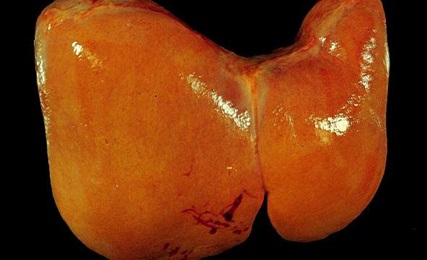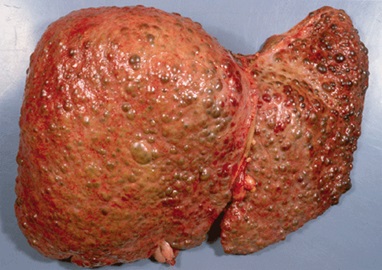FATTY LIVER (Non-Alcoholic Fatty Liver Disease)
Introduction
Fatty liver is a liver disease characterized by fat cells accumulation within the liver. Fatty liver represents a spectrum of liver disease comprising the following points ;
- fat cells accumulation in the liver (steatosis).
- evidence of injury to the liver cells (steatohepatitis).
- scarring process in the liver (fibrosis) and finally leads to
- cirrhosis (hardening) of the liver.
Liver cirrhosis (hardening of the liver) is defined as a severe form of liver scarring which is due to multiple-causes (fatty liver is one of the causes). Liver cirrhosis will lead to the deterioration of the overall functions of the liver (liver failure) and to the liver cancer or also known as hepatoma or hepatocellular carcinoma.
Individual who has fatty liver has been noted to have histopathological changes (microscopic) of the liver resembling an alcohol drinker eventhough they do not take any forms of alcohol, or their alcohol intake is not significant at all. Apart from alcohol, the other causes of fatty liver are due to the side effects of certain medications, post-operative complication of some intestinal surgery and other liver disease such as Wilson disease and chronic hepatitis C .In this article, we focus on non-alcohol-related fatty liver called Non-Alcoholic Fatty Liver Disease (NAFLD)
A typical NAFLD patient is described as one who has multiple problems namely obesity, diabetes mellitus, hypertension, dyslipidemia (high cholesterol levels especially triglycerides). These features are collectively called `metabolic syndrome`.
Previous studies have shown that fatty liver is detectable in about 20% of the population in North America and Europe. As in the Asia Pacific region, the prevalence of fatty liver in Japan is about 30% in the year 2004. The prevalence was more in men with an average age between 40- 49 year old.
Signs and symptoms
Most patients of fatty liver are without any symptoms, however they may have the following features;
- Lethargy
- Abdominal discomfort – commonly on the right side
- Liver enlargement or hepatomegaly
- Abnormal liver function test alanine amino transaminase (ALT) levels and aspartate transaminase (AST) levels. Most of the patients are found to have fatty liver through abnormal liver function test.
Patients who have the most risk to develop NAFLD (ie; those with obesity, diabetes) are usually known to have abnormal liver function test with high levels of ALT and AST. Abdominal ultrasound will detect the presence of fatty liver. However, some patients may be subjected to liver biopsy in order to confirm the presence of fatty liver and its severity.
|
Complications
Patients with a long-standing fatty liver may progress to liver cirrhosis like in any other chronic liver patients. Cirrhotic patients may deteriorate or decompensate with ascites (fluid accumulation in the abdomen), hematemesis or sudden vomiting of blood due to variceal bleeding in the oesophagus and hepatic encepahlopathy (state of coma due to liver failure). They are also at risk of developing liver cancer or hepatoma.
Patients with risk factors for NAFLD such as those with diabetes, hypertension or dyslipidemia should have a proper follow-up with their doctors because most of the patients with fatty liver do not have any prominent symptoms. Early prevention would avoid development of cirrhosis and further complications described earlier.
Treatment
Patients with fatty liver can progress to liver cirrhosis if left untreated. As for that reason, they would need to have an optimum levels of care in their respective diseases such as good diabetic control, reduction of fatty food in order to reduce cholesterol level, good blood pressure control and weight reduction in obese patients. Physical exercise and outdoor activity should be enforced upon patient as exercise is effective in reducing fat cells in the liver. Loss of at least 3-5% of body weight appears necessary to improve steatosis but a weight loss (upto 10%) may be needed ti improved necroinflammation. Healthy lifestyle is to be emphasized as studies have shown that weight reduction would reduce the severity of fatty liver in a patient. There have been trials of medication for fatty liver patient, however the results are certainly not very encouraging.
Prevention
All patient with a substantial risk of developing fatty liver must be identified and given an early treatment. A proper eating habit is of paramount importance as it will avoid obesity. Dietitian consultation is advisable to help the patient. All patient with fatty liver should be referred early to the hepatologist in order to initiate the treatment program. Endocrinologist will help the patient in achieving the optimum diabetic care. The most important preventions are elimination of metabolic syndrome, healthy lifestyle implementation and avoiding excessive eating habits that will lead to obesity.
References
- Nonalcoholic fatty liver disease in the Asia-Pacific region: definitions and overview of proposed guidelines. Journal of Gastroenterology and Hepatology 22:2007;778-787
- Data from electronic publication (www.uptodate.com)
| Last Reviewed | : | 20 June 2014 |
| Writer / Translator | : | Dr. Shamsul Amri Ismail |
| Accreditor | : | Dr. Tan Soek Siam |
| Reviewer | : | Dr. Hamiza bt. Shahar |





.jpg)





